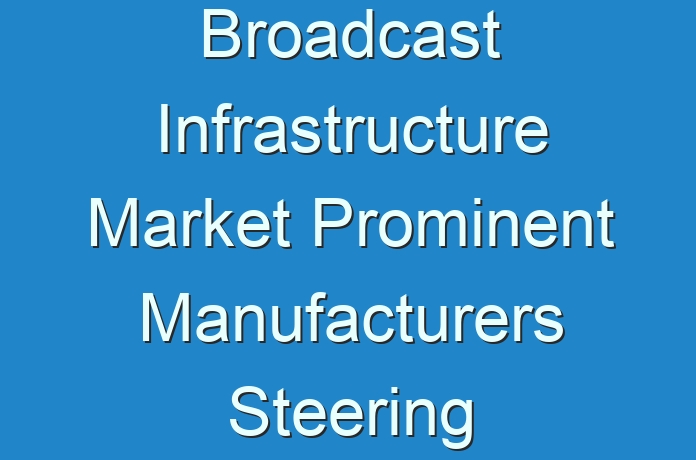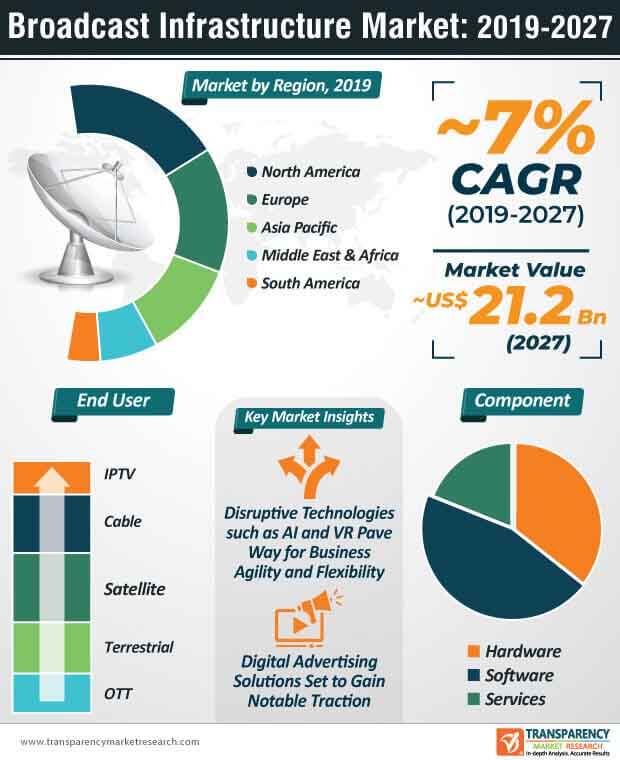
Broadcasters Seeking Cost-effective Delivery Models to Meet Varied Consumer Demand
Broadcast infrastructure is arguably one of the most essential aspects of on-air presentation, and at present, broadcasters are seeking cost-effective solutions to improve their efficiency and overall output. The significant rise in the popularity of over-the-top (OTT) video streaming services, along with ascending Internet penetration, worldwide, is likely to aid the growth of the broadcast infrastructure market in the near future. Owing to remarkable advancements in technology over the past decade, viewers seek the flexibility of viewing content from any location, on any device, and at any given time. Key participants in the market are thus focusing on providing high-quality content across various networks, including digital terrestrial television (DTT) and broadband.
In their quest toward attaining commercial flexibility and agility, market players are developing new solutions in conjunction with the existing ones. This approach has paved the way for infrastructure duplication, isolated systems, and various other operational characteristics. However, at the back of these developments, players in the broadcast infrastructure market have expressed that operational costs are on the rise, and a sustainable delivery model is the need of the hour.
TMR predicts that, the broadcast infrastructure market will grow at a decent CAGR of ~7% from 2019 to 2027, expanding 1.75X by the end of the said period.
Request a sample to get extensive insights into the Broadcast Infrastructure Market https://www.transparencymarketresearch.com/sample/sample.php?flag=S&rep_id=74457
Market Players Eye Potential of IP Technology to Address Content Delivery Barriers
The onset of fresh video formats has played a key role in improving the adoption of IP technology in the last few years. Established market participants are currently exploring the potential benefits of this technology to overcome the barriers put forward by existing content delivery models. The integration of IP technology will not only allow broadcasters to provide high-quality video formats but also assist them with remote production and content delivery. For instance, by adopting IP technology, broadcasters at Wimbledon could use any signal from any court without a different routing infrastructure. The adoption of IP technology within broadcast companies is expected to grow at the back of the entry of SMPTE 2110 into the market. SMPTE 2110 is a major step in moving broadcast production toward IP, and will enable broadcasters to adopt a flexible workflow, as they can efficiently differentiate audio, video, and ancillary data.
Industry experts are of the opinion that, the adoption of IP technology is one of the most disruptive trends within the broadcast infrastructure market sector. However, despite the numerous benefits of this technology, at present, only a few media companies are completely relying on IP, as the inclination toward selective dissemination of information (SDI) infrastructure still remains high. As broadcasters continue to recognize the potential of IP, significant uptake of this technology is expected in the next five years. With broadcast infrastructure swaying toward IP and cloud, media companies and broadcasters are expected to invest in cybersecurity to fend off hackers.

Digitization and Cloud Technologies – Future of Video Broadcasting
In the current day and age, video consumption patterns have witnessed a drastic change, worldwide. To stay relevant in the market, broadcast companies are gradually leaning away from conventional platforms and embracing cutting-edge solutions such as cloud technologies. At present, video on demand (VOD) is predominant in the broadcasting sphere – a trend that is expected to continue in the foreseeable future, as traditional TV viewing continues to take a hit. Steep pricing models, inconsistent broadcast schedules, and lack of flexibility in terms of access are some of the leading factors that have propelled the demand for online broadcasting. Further, conventional processes that are deployed to encode, capture, archive, and distribute video require very high investments in hardware equipment. Production teams are thus moving away from legacy broadcast hardware solutions toward agile and scalable software solutions in the cloud.
To understand how our report can bring difference to your business strategy, Ask for a brochure https://www.transparencymarketresearch.com/sample/sample.php?flag=B&rep_id=74457
These discrepancies in traditional video broadcasting have significantly increased the adoption of cloud-based video solutions that provide the desired levels of speed and flexibility to broadcasters. Industry-grade cloud solutions are designed to tackle redundancy, and broadcasters can deploy their custom-built broadcasting infrastructure across various data centers and regions. Cloud-based solutions enable broadcasters to integrate their services with various software as a service (SaaS) platforms. Owing to the benefits offered by cloud-based technologies, players operating in the broadcast infrastructure market are gradually moving away from conventional broadcasting infrastructure techniques.





